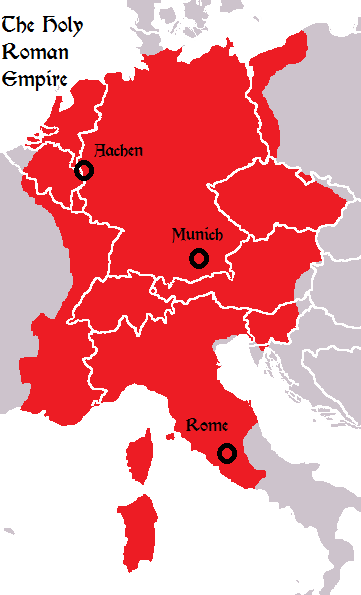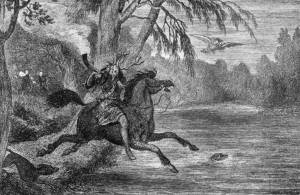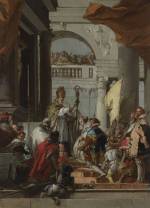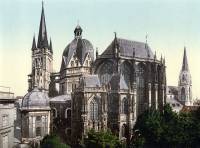The Holy Roman Empire

History
![By David Liuzzo, eagle by N3MO (Own work) [CC BY-SA 3.0 (http://creativecommons.org/licenses/by-sa/3.0)], via Wikimedia Commons By David Liuzzo, eagle by N3MO (Own work) [CC BY-SA 3.0 (http://creativecommons.org/licenses/by-sa/3.0)], via Wikimedia Commons](/_media/banner_of_the_holy_roman_emperor_with_haloes_1400-.png?w=200) After the sack of Rome and the decline and fall of the Western Roman Empire, centralised Roman power in Europe lay dormant for almost 400 years. As increasing migration from the Germanic tribes from the North and siege from the Arabic powers to the South whittled away at Byzantium’s borders, it seemed increasingly likely that the power Rome once held would be forever lost. However in 800 Pope Leo III crowns Charlemagne Emperor of the Romans in a service in St. Peters, setting the stage for the re-emergence of Roman rule. This Carolingian dynasty lasted less than 100 years before it collapsed into a smattering of squabbling states.
After the sack of Rome and the decline and fall of the Western Roman Empire, centralised Roman power in Europe lay dormant for almost 400 years. As increasing migration from the Germanic tribes from the North and siege from the Arabic powers to the South whittled away at Byzantium’s borders, it seemed increasingly likely that the power Rome once held would be forever lost. However in 800 Pope Leo III crowns Charlemagne Emperor of the Romans in a service in St. Peters, setting the stage for the re-emergence of Roman rule. This Carolingian dynasty lasted less than 100 years before it collapsed into a smattering of squabbling states.
Years later, the tradition of electing a King developed in a handful of Eastern Frankish stem duchies beginning with Otto the Great. When an alliance developed between Adelaide - then Queen of Italy - and Otto, their defeat of Adelaide’s enemies in the peninsula united the two nations and in 962 Otto was crowned Emperor. With him there started an unbroken line of Roman Emperors to the current day, though his son Otto II would be the first to style himself as such. These Emperors are the successors of Charlemagne and through him successors to ancient Rome, through transference of rule.
More recently the ley leadership have clashed with the Popes of Rome, with jurisdiction in many areas slowly being wrested away from the position of Emperor. Coming to a climax in the Concordat of Worms (1122) the right to invest bishops, who if appointed wisely could be some of the major political allies to an Emperor, with sacred authority was primarily returned to the hands of the Papacy. At the same time the states of Northern Italy are beginning to pull away from central control, and there have been some which point to this as threatening the very thing that makes the Empire Roman.
Culture
The Holy Roman Empire is not a centralised nation in the way that the English or French countries are, instead it forms a patchwork quilt of smaller states. At the highest levels of the Empire these states are ruled by Monarchs1) and from those Monarchs one is elected who goes on to be crowned Holy Roman Emperor by the Holy See. Though an Emperor in name, whoever holds the throne of the Empire does not have the power of the Caesars of ancient times and the Monarchs have a great deal of autonomous power in their own regions. Nowhere is this truer than in the states that make up the northern provinces of the Italian peninsula: ever since the Investiture Controversy they have pulled away from the Empire to greater self-determination or deference to the Papal States.

During the last 50 years or so the current Emperor, Frederick Barbarossa, has made a great number of changes to the setup of the Empire. From building new cities of the likes of Freiburg and Munich, to establishing the Landfrieden legal system – designed to prevent violence being the first resort - to establishing armies with and bestowing land to Ministerialia, who were previously non-free people, the pattern in Barbarossa’s reforms all seem to be pushing towards reclaiming centralised power for the Emperor.
The average people of the Empire - especially in the Germanic states - are deeply superstitious, and many aspects of their lives are ruled by ritual: both sacred and supernatural. From dedicated prayers to local Saints, to appeals to minor fairies that hide themselves away from prying eyes a peasant, or even a noble, has many routes by which they could hope to get non-human aid in their daily endeavours. However this abundance of magic has a darker side; none would dare walk the woods alone at night, lest they find themselves pulled into the den of some darker spirit.
Major Places
- Rome: Although not the Capital City, few could deny the position and prestige of Rome among Europe as a whole, let alone the Empire. It is a hub of both sacred and secular power and a fortress against attack in times of war. Little can be said about Rome that has not been said before: it is arguably the most valuable city in Europe, and many would kill and die for the opportunity to rule it.
- Aachen: The Capital of the Empire, and the city in which most Kings of the Romans have been crowned since Charlemagne himself. Though not a fixed hub for Imperial authority, which is itinerant through the many states of the nation, the Palantine Chapel is considered second only to St. Peters in Rome.
Notable People

- Frederick Barbarossa, Holy Roman Emperor: As Emperor, opinions on Barbarossa are sharply divided between those who think that he is attempting to take all the power in the Empire for himself, and those who were personally appointed by him. Although he is known to be a terrifyingly effective and ruthless Emperor, it is unlikely that those without land will have felt the effects of his reforms.
- Pope Mary IV: As a counterpoint to the Emperor, the office of the Papacy is held by one as equally driven and competent. Bolstered by the work of her predecessors, many of her sermons have preached the independent strength of the Church, and previous divisions with the Empire and Byzantium in the East continue to show. She is famed to be inspiring and uncompromising in the eyes of the good Christian people, though opinion on whether this is for the better or the worse is wildly varying.
- Henry the Lion: The Weif and Hohenstaufen dynasties have long been at each other’s throats, and with the former Duke of Bavaria’s second exile from the Germanic states this does not seem likely to end any time soon. Little has trickled back to the peasantry of Henry's nature and ambitions, but any news from his former fief of Munich is spotted with dark rumours. Of what - who could say? They keep to themselves.
